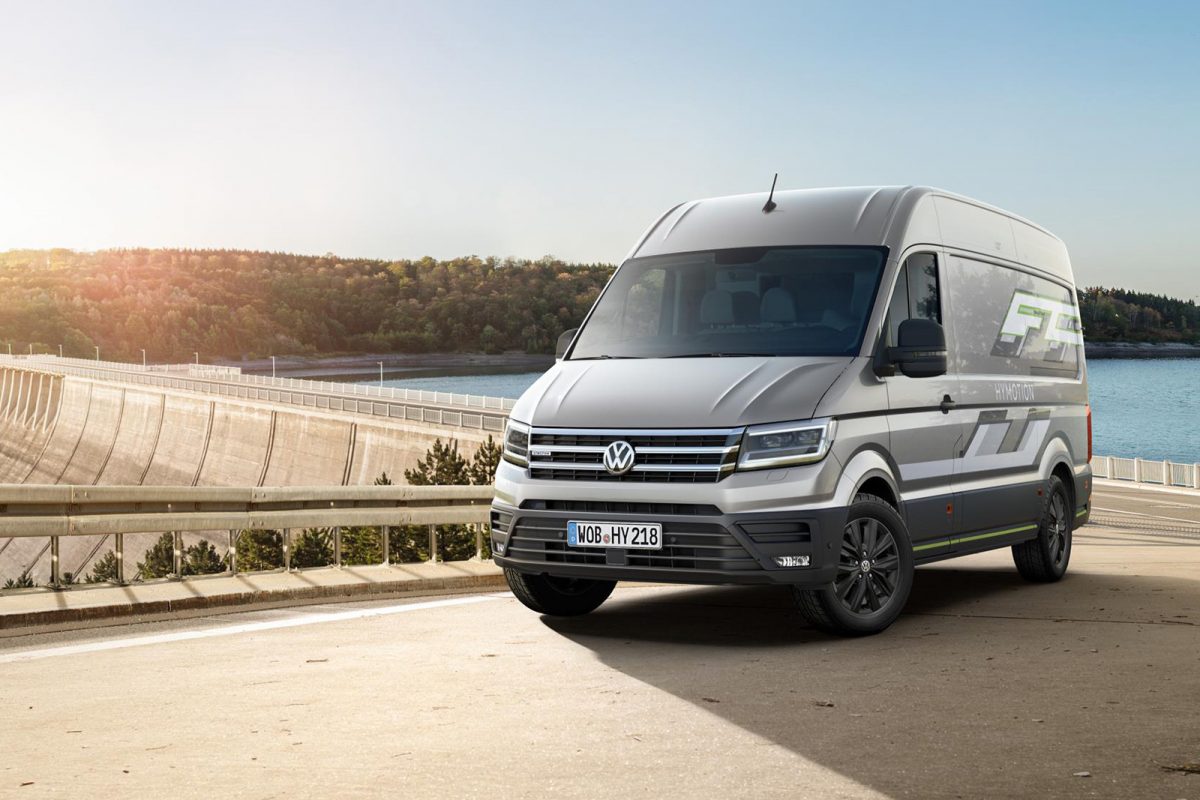Volkswagen Commercial Vehicles is electrifying the 2018 IAA Show with five new zero-emission models

Volkswagen Commercial Vehicles is electrifying the industry with an electric mobility campaign. At the 69th IAA Commercial Vehicles show (20 to 27 September), the specialist in innovative transport solutions is presenting no less than five new zero-emission vehicles – creating a new matrix of electric mobility for commercial use. Making their world debuts are the I.D. BUZZ CARGO, ABT e-Transporter, ABT e-Caddy, the Cargo e-Bike and the Crafter HyMotion which is equipped with a hydrogen fuel cell drive system.
World premiere I: I.D. BUZZ CARGO
Exactly one month ago, Volkswagen introduced the first new model in its electric mobility campaign, the new e-Crafter, with pre-sales of the electric van beginning this month. The electric campaign is now gaining momentum at the 2018 IAA Commercial Vehicles show. One highlight is the I.D. BUZZ CARGO1 concept – the first commercial vehicle to be based on the new I.D. Family and the modular electric drive kit (MEB). It embodies a new progressive design DNA, extremely good space, an automated driving mode (“I.D. Pilot”), a digitalised cargo system and long ranges. The MEB enables ranges from approximately 330 to more than 550 km (per WLTP) – depending on the battery size and the specific model.

World premiere II: Crafter HyMotion
Volkswagen Commercial Vehicles is also demonstrating a new alternative fuel direction with the world premiere of the Crafter HyMotion1 – a van with a hydrogen fuel cell drivetrain. The Crafter HyMotion was specially designed for longer journeys: the longer the daily distance covered, the greater the appeal of the hydrogen fuel cell in large commercial vehicles. The tanks integrated in the Crafter HyMotion have a capacity of 7.5 kg hydrogen. This enables the 4.25-tonne van to cover driving ranges of more than 500 km.
The time required to refill the Crafter HyMotion is comparable to that for conventionally powered models. This fact makes the new zero-emission version especially attractive for business use. Despite its significantly longer driving range, the Crafter HyMotion offers an even larger payload than the e-Crafter. The Crafter HyMotion is still a concept vehicle – but as soon as the infrastructure is right, the van could launch with its zero emission electric motor. The Crafter HyMotion is the second concept vehicle from Volkswagen Commercial Vehicles to feature a hydrogen fuel cell; it follows the Caddy Maxi HyMotion, which was first introduced in the “Hydrogen Road Tour” in 2009.

World premiere III: ABT e-Transporter
Volkswagen Commercial Vehicles has offered its Transporter model series for eight decades. Now the brand is connecting the best-selling vehicle’s drive system with electricity: in the world premiere of a taxi concept – the ABT e-Transporter1. This concept car, designed together with the company Abt e-Line GmbH, is a zero-emission van designed to generate electricity at IAA Commercial Vehicles.
The battery system of the ABT e-Transporter is constructed to be scalable so that it can satisfy the needs of a wide variety of potential applications and budgets in a possible production model. In its base configuration, the Transporter comes with a lithium-ion battery that has an energy capacity of 37.3 kWh; the second battery version offers an energy capacity of 74.6 kWh. Driving ranges of the two versions are between 208 and 400 km.

World premiere IV: ABT e-Caddy
The second model designed jointly by Abt e-Line GmbH and Volkswagen Commercial Vehicles is the ABT e-Caddy1, which is also being shown in a world premiere at the IAA. It will arrive on the market in the middle of next year. Volkswagen Commercial Vehicles is also presenting the ABT e-Caddy as a taxi, and for good reason: it is based on the extended Caddy Maxi and therefore offers ample space for five people plus luggage.
With a range of up to 220 km (forecast NEDC figures), the zero-emission vehicle has been ideally tailored for urban use in the environmental restriction zones of European cities. An 82-kW electric motor operates in the ABT e‑Caddy. The electric motor is supplied with electricity from a lithium-ion battery. Energy capacity: 37.3 kWh. The ABT e-Caddy, which has a top speed of 120 km/h, will be one of the most spacious electric vehicles in its class with a cargo compartment volume of 4.2 m3.

World premiere V: Cargo e-Bike
Volkswagen Commercial Vehicles is also writing history at IAA 2018 with the brand’s first electric bike: the Cargo e-Bike – a “last mile deliverer” that is the most advanced of its kind in the world. Market introduction of the three-wheel cycle will be in 2019. The Cargo e‑Bike1 is a pedelec (pedal electric cycle) that adds power assistance to its rider’s pedalling with a 250 Watt (48V) mid-mounted motor at speeds up to 25 km/h. Advantages of a pedelec: It can be used anywhere, even in pedestrian zones. Energy for the electric motor is supplied by a lithium-ion battery. The drive and rugged architecture of the cargo bike are designed for a maximum payload of 210 kg (including rider).
This vehicle – the smallest Volkswagen commercial vehicle ever – is equipped with two wheels at the front, with the load platform positioned low between them. Mounted on this load platform is a cargo box with a storage volume of 0.5 m3. Innovative kinematics of the front axle ensure that the goods being transported on the load platform do not tilt with the cargo bike when cornering, rather they remain horizontal and thereby stable. This tilt-levelling technology is an innovation. The new electric Cargo e-Bike will be produced at the Volkswagen Commercial Vehicles plant in Hannover.

Credit: Volkswagen
